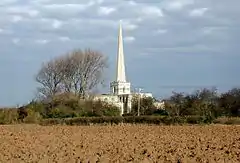St Mary the Virgin, Hemingbrough
The church of St Mary the Virgin, Hemingbrough is a Grade I listed building in Hemingbrough, district of Selby, North Yorkshire, England.[1] It is also known as Hemingbrough Minster.

History
The building originates from the late 12th century CE, additions were made in the 13th, 14th, and 15th centuries.[1] William the Conqueror gave the church to the prior and convent of Durham. On 26 October 1426 Henry VI gave licence to convert it into a collegiate church with residentiary canons whose period of residence was thirteen weeks each. From 1479 this also applied to the provost who until then was compelled to be resident for the greater part of the year. There were also three prebendaries, six vicars, and six clerks.[2] The college was suppressed in 1545.
Architecture
The church is of a cruciform layout and mostly built in the later English style. The tower is square and carries battlements and an octangular spire.[3] The tower was added in the 13th century, the spire which reaches a height of 191 feet (58 m) between 1416 and 1446. The nave is aisled and has four bays, as has the south aisle of the chancel. The chapter house has three bays. The vestry lies to the north. North and south transepts have two bays each.[1]
References
- Historic England. "Church of St Mary the Virgin (1148462)". National Heritage List for England. Retrieved 12 January 2020.
- William Page, ed. (1974). "Collegiate churches: Other churches (except Beverley and York)". A History of the County of York. British History Online. 3. London. pp. 359–375. Retrieved 12 January 2020.
- Samuel Lewis, ed. (1848). "Helmsley - Hemington". A Topographical Dictionary of England. British History Online. London. pp. 470–474. Retrieved 12 January 2020.